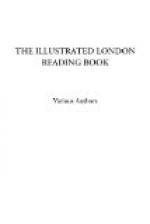[Illustration: Goliah Aratoo.]
From the general conformation of the parrots, as well as the arrangement and strength of their toes, they climb very easily, assisting themselves greatly with their hooked bill, but walk rather awkwardly on the ground, from the shortness and wide separation of their legs. The bill of the parrot is moveable in both mandibles, the upper being joined to the skull by a membrane which acts like a hinge; while in other birds the upper beak forms part of the skull. By this curious contrivance they can open their bills widely, which the hooked form of the beak would not otherwise allow them to do. The structure of the wings varies greatly in the different species: in general they are short, and as their bodies are bulky, they cannot consequently rise to any great height without difficulty; but when once they gain a certain distance they fly easily, and some of them with rapidity. The number of feathers in the tail is always twelve, and these, both in length and form, are very varied in the different species, some being arrow or spear-shaped, others straight and square.
In eating, parrots make great use of the feet, which they employ like hands, holding the food firmly with the claws of one, while they support themselves on the other. From the hooked shape of their bills, they find it more convenient to turn their food in an outward direction, instead of, like monkeys and other animals, turning it towards their mouths.
The whole tribe are fond of water, washing and bathing themselves many times during the day in streams and marshy places; and having shaken the water from their plumage, seem greatly to enjoy spreading their beautiful wings to dry in the sun.
* * * * *
THE PARROT.
A domestic anecdote.
[Illustration: Letter T.]
The deep affections of the
breast,
That Heaven to
living things imparts,
Are not exclusively possess’d
By human hearts.




